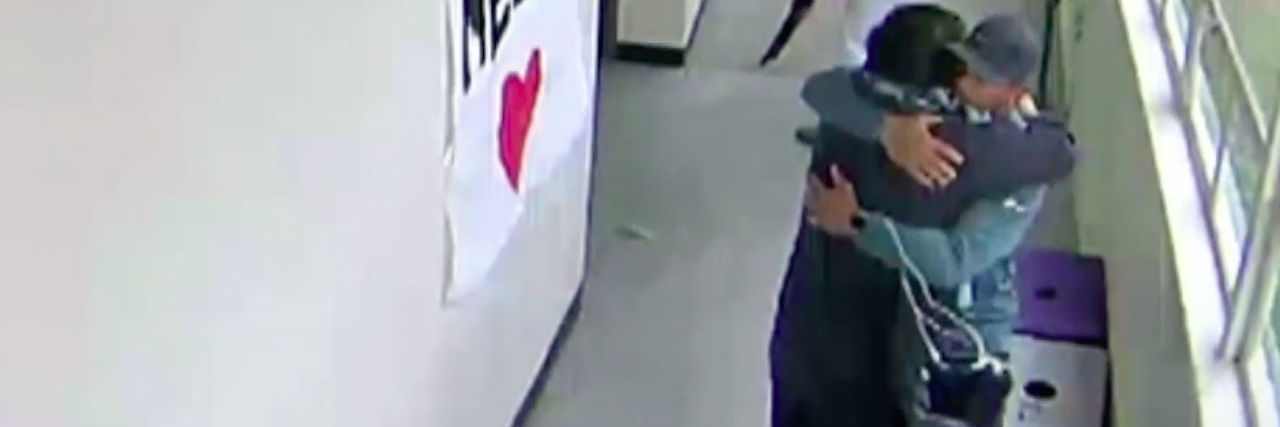3 Things to Consider Before Sharing the Viral Video of the Coach Hugging Student With Gun
Sometimes the news isn’t as straightforward as it’s made to seem. Juliette Virzi, The Mighty’s mental health editor, explains what to keep in mind if you see this topic or similar stories in your newsfeed. This is The Mighty Takeaway.
Editor's Note
If you experience suicidal thoughts, the following post could be potentially triggering. You can contact the Crisis Text Line by texting “START” to 741741.
If you’ve been keeping up with the news recently, you might have seen people sharing newly-released surveillance footage of school coach Keanon Lowe disarming, then bear-hugging Angel Granados-Diaz, a suicidal student who brought a shotgun to school. The incident occurred in Portland, Oregon earlier this year on May 17. No one was injured.
“I felt compassion for the kid, to be honest,” Lowe later told the press. “I had a real-life conversation. Obviously, he broke down and I just wanted to let him know that I was there for him. I told him I was there to save him — I was there for a reason and that this is a life worth living.”
Stunning surveillance footage captured the moment a high school coach in Oregon disarmed a student with a shotgun and then embraced him. Police eventually arrived and took the student into custody. https://t.co/a5artNKKlJ pic.twitter.com/rIKG9Phl0e
— ABC News (@ABC) October 19, 2019
Most social media responses praised Lowe for his quick thinking and act of compassionate bravery. And while we absolutely should commend Lowe for defusing a dangerous situation, when we talk about this story, we can’t forget about Granados-Diaz — the student who was in so much mental distress that he brought a gun to school to kill himself.
Here are three things we need to keep in mind about this viral story:
1. This Story Isn’t About a School Shooter
As we all know, in recent years, mass shootings have been a devastating fixture in the news. According to Vox, since the Sandy Hook Elementary School shooting in 2012, there have been 2,265 mass shootings in the United States.
But this particular story is not about a school shooter. Authorities determined Granados-Diaz was experiencing a mental health crisis and was attempting to die by suicide — without the intention of harming anyone but himself. On Thursday, he was sentenced to three years of probation.
“Through the course of the investigation it became clear to law enforcement and our office that Mr. Granados-Diaz did not have the intent to hurt anyone other than himself while at Parkrose High School,” Parakram Singh, deputy district attorney, said.
Some news outlets have labeled Granados-Diaz a “school shooter.” Not only is this inaccurate, it’s potentially dangerous. When we conflate Granados-Diaz with other school shooters, we may by extension imply that school shooters “just need a hug.”
Yes, Lowe’s actions were what Granados-Diaz may have needed at the moment to de-escalate, but that doesn’t mean we should hold up hugs as the way to de-escalate any school shooter. The reality is, people intending to inflict mass violence on others need more than a hug — they need robust professional support and care that laypeople are simply not equipped to provide.
2. Not All Suicidal People Need a Hug
We are so grateful that Lowe’s act of kindness was seemingly what Granados-Diaz needed at that moment. One of the most important ways we can help people who are suicidal is to meet them where they are — and in this incident, that’s exactly what Lowe did.
But just as we shouldn’t jump to the conclusion that school shooters simply need a hug, we also can’t assume all suicidal people want to be hugged either. In fact, some suicidal folks (particularly those with a history of trauma), may not want to be touched at all, as it may be triggering to them.
Most of us won’t encounter a crisis-level situation like this in our lives, but many of us will know someone struggling with suicidal thoughts. As a rule of thumb, asking what your suicidal loved one needs is one of the best things you can do to show you care. Questions like, “Can I hug you?” or “What can I do for you?” can go a long way. These questions give the suicidal person agency in letting you know what they need.
3. We Can’t Forget Granados-Diaz — and All the Other Students Who Need Mental Health Help
There’s nothing wrong with celebrating Lowe’s actions — after all, he did prevent a tragedy from occurring — but the biggest takeaway from this story should not be Lowe or his hug.
When we talk about this story, we should talk about how even though one in five children struggle with a mental, emotional or behavioral disorder, only 20% receive care from a mental health care provider. When we talk about this story, we should mention the fact that suicide is the second leading cause of death in people ages 10 to 34 in the U.S. When we talk about this story, we need to discuss how the only time we talk about mental illness is when it gets to a crisis-level situation.
This story shouldn’t be about a hero with a hug. This story is evidence of the simple reality that our students deserve better mental health support than we are giving them. We need more than just hugs to fix this problem.
Header screenshot via NBC Nightly News

